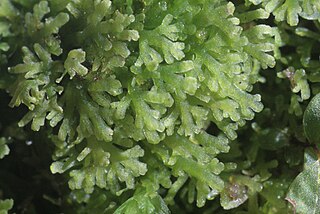| Pallaviciniales | |
|---|---|
 | |
| Phyllothallia nivicola (Phyllothalliaceae). | |
| Scientific classification | |
| Kingdom: | |
| Division: | |
| Class: | |
| Order: | Pallaviciniales W.Frey & M.Stech 2005 |
| Families | |
| |
Pallaviciniales is an order of liverworts. [1] [2]
| Pallaviciniales | |
|---|---|
 | |
| Phyllothallia nivicola (Phyllothalliaceae). | |
| Scientific classification | |
| Kingdom: | |
| Division: | |
| Class: | |
| Order: | Pallaviciniales W.Frey & M.Stech 2005 |
| Families | |
| |
Pallaviciniales is an order of liverworts. [1] [2]

The Elopiformes are the order of ray-finned fish including the tarpons, tenpounders, and ladyfish, as well as a number of extinct types. They have a long fossil record, easily distinguished from other fishes by the presence of an additional set of bones in the throat.

Marchantiales is an order of thallose liverworts that includes species like Marchantia polymorpha, a widespread plant often found beside rivers, and Lunularia cruciata, a common and often troublesome weed in moist, temperate gardens and greenhouses.

Marchantiopsida is one of three classes within the liverwort phylum Marchantiophyta.

Jungermanniales is the largest order of liverworts. They are distinctive among the liverworts for having thin leaf-like flaps on either side of the stem. Most other liverworts are thalloid, with no leaves.

Metzgeriales is an order of liverworts. The group is sometimes called the simple thalloid liverworts: "thalloid" because the members lack structures resembling stems or leaves, and "simple" because their tissues are thin and relatively undifferentiated. All species in the order have a small gametophyte stage and a smaller, relatively short-lived, spore-bearing stage. Although these plants are almost entirely restricted to regions with high humidity or readily available moisture, the group as a whole is widely distributed, and occurs on every continent except Antarctica.

Jungermanniopsida is the largest of three classes within the division Marchantiophyta (liverworts).

Frullania is the only genus of liverworts in family Frullaniaceae. It contains the following species:

Pleurozia is the only genus of liverworts in the family Pleuroziaceae, which is now classified in its own order Pleuroziales, but was previously included in a broader circumscription of the Jungermanniales. The genus includes twelve species, and as a whole is both physically distinctive and widely distributed.

Haplomitrium is a genus of liverwort.

Porellales is an order of liverworts.